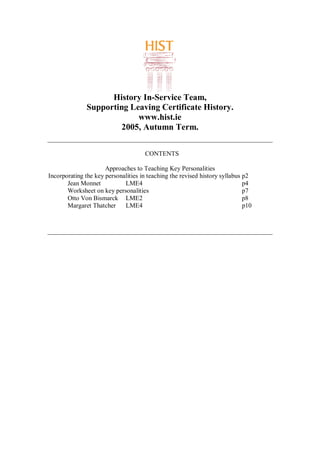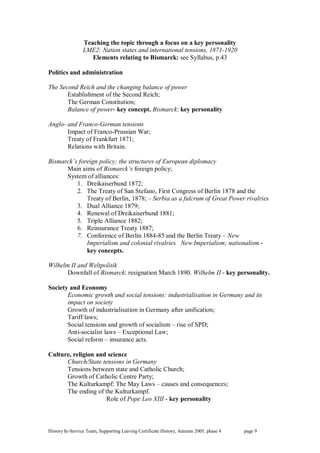This document provides information about teaching key personalities in the revised Leaving Certificate history syllabus in Ireland. It discusses Jean Monnet as a key personality in the topic of division and realignment in Europe from 1945-1992. The document outlines Monnet's role in moves toward European unity after World War 2 and the establishment of the European Economic Community. It suggests teaching strategies like using worksheets to focus on Monnet's influence on relevant elements and concepts like the common market and federal Europe. The document also provides biographical details about Monnet's career and involvement in post-war French economic reconstruction and advocacy for greater European integration.










![History In-Service Team, Supporting Leaving Certificate History, Autumn 2005, phase 4 page 11
• Photograph slideshow: Photographs do not exist in a vacuum. There are
reasons why a photograph like this is available on the historical record. Keep
the following in mind - the decisions the photographer has made in creating
this image; how the photograph is being used; the context in which this image
is being seen.
• Key information on interpreting historical photographs and a grid which may
be helpful for teachers and students studying historical photographs is
available on p.27 of the Guidelines.
• Cartoons
o The cartoonist’s stance towards his/her subject matter will always
influence how we see the picture/cartoon. Cartoonists are not
concerned with presenting a balanced view. To present their point of
view in a lively manner, they rely heavily on caricature and
exaggeration.
o Cartoons are often best used towards the end of work on a topic when
students have the knowledge to help them recognise and decipher the
clues in the cartoon.
• Cartoon web site:
The website of the Centre for the Study of Cartoons and Caricature
[http://library.kent.ac.uk/cartoons/] has a collection of 119,636 (!) political
cartoons. The Centre was established in 1973 at the University of Kent to
collect and preserve British cartoons of social and political comment, and
make them freely available for study. All of these cartoons were taken from
this site. Please note that there might be copyright issues involved in using
some of these cartoons.
The challenge of using cartoons may be more difficult than might be
appreciated at first. A recent Historical Association (London) paper
commented: “It has often been pointed out that cartoons are conceptually
highly complex, and extremely difficult for young people, especially the lower
attaining, to understand … Many pupils find it difficult to understand pictures
in anything other than a literal sense, so that much of the message of this
cartoon will almost certainly be lost on them” [Historical Association, History
14-19 (London, 2005), p39].
• Analysing Cartoons: Page 28 in the Guidelines has a grid for analysing
cartoons. This activity was also covered in Phase 3 of inservice (p32 of the
inservice booklet). This is available on our website, www.hist.ie.](https://image.slidesharecdn.com/teachingkeypersonalities-140406140314-phpapp01/85/Teaching-key-personalities-11-320.jpg)


